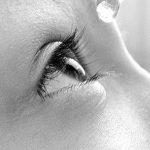The eyes are a valuable asset: however, not everyone is fully aware of the many needs and dangers that could threaten their health.
Many people use contact lenses and almost all women's eyes are in contact with different types of cosmetics for most of the day. In addition, we all use smartphones, PCs and tablets and often spend many hours staring at these digital devices, now inseparable companions in our daily lives. This prolonged use often becomes the cause of visual fatigue, red eyes, burning and dry eye feeling.
Some data:
 1. Excessive use of digital devices
1. Excessive use of digital devices
Worldwide about 90% of people use digital devices for more than 2 hours a day and of these the 60% for more than 5 hours.
Often, at the end of a long day, one has a severe headache, blurred vision, dry and very tired eyes, which is a sign that one has spent too much time in front of an electronic device.
It is a problem that ophthalmologists call "Computer Vision Syndrome (Cvs)which affects almost all people who spend more than two hours a day with their eyes glued to a screen, be it a PC, an eBook or a smartphone.
Visual fatigue could also be among the causes that favour the progression of the myopia and the onset of a disorder called asthenopiaa condition of eye fatigue caused by excessive strain on the eyesight.
2. Contact lenses and visual discomfort
a) In Italy, contact lens wearers are approximately 4 million and represent the 10% of those with visual defectshalf of these are under 30.
b) Recent research confirmed that habitual contact lens wearers from Italy, the USA, Germany and China, in about 60% of caseswear the lenses for more than eight hours a day.
(c) About the 80% of contact lens wearers suffers from eye fatigue related to using smartphones, tablets or other devices for more than two hours a day. However, in 65% of cases, contact lenses are replaced by prescription glasses for activities such as reading, watching TV or continuing to use digital devices at the end of the day. In Italy, the percentage of the latter rises to 92%.
d) Intensive use of smartphones, tablets and PCs can also cause eye stress for the Continuous switching of focus between near and faras well as lacrimation alterations due to reduced blinking resulting in irritation and eye inflammation symptoms.
This problem is even more pronounced in contact lens wearers, particularly those who use them for more than eight hours a dayThis can cause chronic inflammatory states and an increased susceptibility to developing infections of the conjunctiva and cornea.
 Why ocular hygiene is so necessary
Why ocular hygiene is so necessary
The surface of our eyes and our eyelids are at high risk of contamination and proliferation of bacteria and other micro-organisms. This vulnerable condition is linked to a number of factors, first and foremost the predominantly aqueous nature of the microenvironment of the eyelids and ocular surface.
It can also often result in the presence of excessively oily secretions, which partially or completely obstruct the Meibomian glandsimportant in the correct balance of the tear film that coats, nourishes and protects the surface of our eyes.
Small crusts and keratinised substances due to normal cell turnover can then accumulate on the eyelashes and eyelid margins.
This obstruction causes excessive tear evaporation, which can contribute to the onset of tear dysfunction syndrome, better known as 'dry eye' syndrome.
Dry eye syndrome or "dry eye syndrome is a multifactorial disorder that affects the tear film and ocular surface and can be traced back to two main hypotheses: 1) an inadequate quantity of tears; 2) a deficit in tear composition.
 Counselling and recommendations
Counselling and recommendations
Washing with soap and water alone does not ensure effective cleaning of the eyelid margin.
In all cases in which appropriate hygiene of the periocular area is necessary, it may be appropriate, in order to alleviate discomfort and assist medical treatment, to use specific medical devices which contain natural components with a moisturising, soothing and anti-inflammatory action and a disinfectant action.
These include Hyaluronic Acidnormally by the human body, a substance with a moisturising and humectant action, useful for removing residues on the eyelid edge, Aloe and Marigold with anti-inflammatory and healing action.
Other substances of a synthetic nature can be used for their disinfectant properties: among them the ChlorhexidineIt has a broad-spectrum antiseptic action, active against Gram-positive and Gram-negative bacteria, as well as against fungi and protozoa, capable of reducing the presence of infectious agents, frequently present on the irritated eyelid rim.
It is good to ensure that you always take in the right amount of water, about two litres a day, in order to maintain a adequate water supply. The lack of the latter, in fact, leads to a reduction in tear production.
Finally, especially in air-conditioned rooms, both in winter with heating and in summer with cold air conditioning, it is advisable to use a humidifier to prevent the air from becoming too dry causing eye irritation.
 Some useful tips from the AAO (American Academy of Ophthalmology)
Some useful tips from the AAO (American Academy of Ophthalmology)
- Carrying out regular eye examinations
- Maintain a distance of approx. 60 cm from the computer monitor, looking slightly downwards
- Use any device filters to reduce brightness
- Take breaks following the 20-20-20 rule - every 20 minutes, secure an object at 20 feet (6 metres), for at least 20 seconds;
- For those who wear contact lenses for prolonged periods, alternate them with prescription glasses. And, when choosing spectacle lenses, get expert advice on which features are best suited to your needs. And even if there are no particular eyesight defects or disorders, it is important to consider, on the advice of your ophthalmologist, the appropriateness of wearing resting spectacles.
This article can also be downloaded in pdf format. To download click here: Sheet 1 - Ocular Hygiene
© Copyright "l'Oculista italiano" - April 2019
Dr. Carmelo Chines
Direttore responsabile
